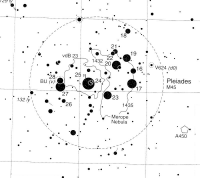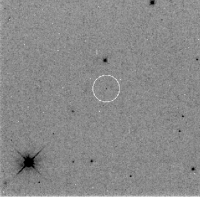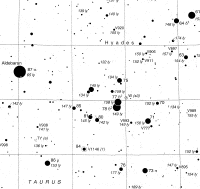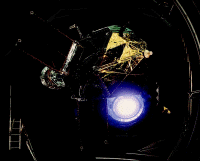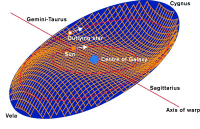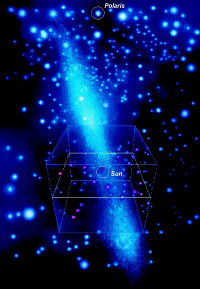Hipparcos: stars in 3-D
New puzzle: key stars are closer than expected
Visible to the naked eye in the constellation of Taurus, the Pleiades have a special place in the science of the stars. Heavy stars burn up faster and grow old more rapidly than less massive stars. As all the stars of the Pleiades cluster formed at the same time, scientists can see how the mass of each star affects its luminosity, colour and ageing. Theories of stellar evolution, worked out using the Pleiades and other clusters of stars, under-pin all efforts to understand the Universe and to predict, for example, how long the Sun will survive.
Figure 2. Pleiades in Millennium Star Atlas (Sky Publishing Corporation and ESA)
But when Hipparcos measured the distance of the Pleiades, the theories looked wrong. At 385 light-years, the star cluster is 10 percent closer than previously thought. The stars are 20 per cent less luminous - a huge discrepancy with the standard theories. Scientists reacted to the Hipparcos result with words like "amazement", "alarm" and even "nightmare".
Hipparcos scientists can find no reason to think that the measurement is faulty, so the theorists are left scratching their heads about how to put matters right.
|
| |
|
Floor van Leeuwen | |
|
|
"Some colleagues are so unhappy about the unexpected distance of the Pleiades, they insist that Hipparcos is wrong," said Floor van Leeuwen of Cambridge University, UK. "After checking it in several ways, I'm sure Hipparcos gave the right answer. So don't use old theories to 'correct' new data. Let's develop better theories."
Figure 3. C.F. Quist et al. using data from Hipparcos (ESA)
Hipparcos was not conceived as an imaging telescope. It measured angles between points of light in the sky. But by combining repeated observations from different phases of the satellite's operating life, Swedish astronomers made the succession of images shown above.
Two stars shift their positions as they orbit around each other. The precision is astonishing.
The stars are 34 light-years away in the Hydra constellation. They lie as close together as do the Sun and the planet Saturn. Their separation in the sky is only 1/5 000°. Yet the Hipparcos results show them plainly circling, and also moving together towards the east (left) in the course of two years.
Double stars are very useful in enabling astronomers to gauge the masses of stars. In this case the mass of the upper star is 0.41 times the mass of the Sun, and that of its companion is 0.42.
Hipparcos observed 24 000 double stars, of which 10 000 were not previously known to be double. The mission also investigated changes in luminosity of 8 000 new variable stars, in addition to 4 000 known variables - thus greatly improving the knowledge of how variable stars behave.
"Astronomers have always lived by their wits," said Lennart Lindegren of Lund Observatory, Sweden. "It was never easy to extract information from those small and distant lights in the sky. Now we're glad to show our colleagues some new tricks to make the Hipparcos results even more useful."
Fixed: an amazing star that flashes gamma-rays
Star data from Hipparcos, and images from ground observatories and the Hubble Space Telescope, fixed the position of a faintly visible neutron star, Geminga. It flashes gamma-rays and X-rays towards the Earth 252 times a minute, with the regularity of an atomic clock.
Figure 4. Geminga. HST (NASA & ESA)
|
| |
|
Patrizia Caraveo | |
|
|
"We needed Hipparcos to finish a long and complicated task of tracking down Geminga," said Patrizia Caraveo of the Institute of Cosmic Physics in Milan, Italy. "Never before was so faint an object pinpointed so precisely."
To compensate astronomers for an embarrassment about the Pleiades, Hipparcos makes them far more confident about the Hyades. This is a second cluster of stars in theTaurus constellation that looms large in star theory. Experts from ESA, and from Leiden (Netherlands), Paris-Meudon and Côte d'Azur (France) and Lausanne (Switzerland), analysed Hipparcos data on more than 200 stars in the Hyades cluster.
Figure 5. Hyades in Millenium Star Atlas (Sky Publishing Corporation and ESA)
Astronomers were unsure about the distance of the Hyades, before Hipparcos. Now they know that the centre of the cluster is at 151 light- years. The uncertainty is less than one light-year. The cluster moves across the sky, and Hipparcos also plots movement of stars within the Hyades, in a 3-D motion picture.
Gravity has held the stars together since their birth 625 million years ago, when only primitive animals lived on Earth. But Hipparcos reveals that some stars are now quitting the Hyades tribe.
"The Hyades cluster has almost assumed the role of the Rosetta Stone of astronomy," said Michael Perryman of ESA's Space Science Department at Noordwijk in the Netherlands. "It allows us to decipher many mysteries of stars. Uncertainties in the observations left it muddy and hard to read with confidence. Let's say we've now cleaned this Rosetta Stone to the point of complete legibility."
The Milky Way: it's floppy and it changes shape
The band of light across the night sky, the Milky Way, is the flattened disk in which many stars including the Sun orbit around the centre of our Galaxy. From Hipparcos results on many distant outlying stars, astronomers from Turin Observatory, Italy, and Oxford University, UK, deduce that the disk is slightly warped, like the brim of a hat. What's more, the distant stars are travelling in unexpected directions which, if continued, will change the shape of the Milky Way.
Figure 7. The warp in the Milky Way (Osservatorio Astronomico di Torino, vertical scale x 10)
"The extraordinary accuracy of Hipparcos convinces us that distant stars have altered course," said Richard Smart of Turin Observatory. "If we knew why, we'd be a lot wiser about the unseen hand of gravity at work in our Galaxy and others."
The harvest of discoveries from Hipparcos has only just begun, as ESA's gift to the world's astronomers opens a new era in their research. Besides the 120 000 stars of the main Hipparcos Catalogue, charted with the highest precision, the scientific team also produced the Tycho Catalogue in which a million stars are detailed with lesser but still remarkable accuracy. Aptly named is the Millennium Star Atlas, based on the Hipparcos and Tycho Catalogues, which is the finest-ever product of celestial cartography.
Scanning the Hipparcos and Tycho Catalogues is made easy by provision of the data on the Internet and on CD-ROMs. Celestia 2000 is a single CD-ROM devised for amateurs as well as professional astronomers to consult on personal computers. For information on how to obtain the products at modest cost, visit: http://astro.estec.esa.nl/Hipparcos/.
ESOC: Darmstadt's role in ESA's Science Programme
On the outskirts of historic Darmstadt in Germany, expert teams are in daily touch with spacecraft in orbit, at ESA's European Space Operations Centre. Worldwide networks of ground stations, permanent or ad hoc, provide the links. Since 1968, ESOC has controlled 17 scientific spacecraft and a similar number of applications satellites.
Figure 8. Hipparcos dedicated control room
|
| |
|
David Dale | |
|
|
"We've always used rather small teams," said David Dale, ESA's director of technical and operational support. "Yet our successes in spacecraft control, in good times and in emergencies, are enviable. Bringing ESOC under a single directorate with our science and technology centre at ESTEC consolidates the teamwork we achieved over many years."
Last updated: 05 April 2000
A riddle solved: older Universe, younger stars
Europe gave an extraordinary gift to the world's astronomers in 1997. ESA's Hipparcos Catalogue told them the positions and motions of 120 000 stars, far more accurately than they ever knew before. It was the product of a unique space mission, using a satellite to fix the stars and so to improve mankind's grasp of the Universe.
For four years, 1989-1993, ESA's Hipparcos satellite scanned the sky, measuring the angles between stars. The largest computations in the history of astronomy then figured out where each star was, and how it moved, with an accuracy 100 times better than previous sky surveys.
|
| |
|
Michael Feast | |
|
|
"Hipparcos cured a headache for cosmologists," said Michael Feast of Cape Town University, South Africa. "We now judge the Universe to be bigger and therefore older, by about a billion years. The oldest stars are much younger than supposed, by about four billion years. If the Universe is about 12 billion years old, everything fits nicely."
|
Figure 1. Neighbouring stars | |
|
|
Scientists now possess, for the first time, a good three-dimensional picture of the bright stars in our neighbourhood. Hipparcos measured the distances of many stars, which were previously a matter of guesswork. For example Polaris, the Pole Star, is 430 light-years away.
Hipparcos hit the headlines in 1997 when it showed that the chief measuring rod for the Universe was wrongly marked. Bright blue stars called Cepheids, of which Polaris is one, vary in luminosity in predictable ways. Astronomers use them to gauge distances of galaxies and the scale of the cosmos. But Hipparcos revealed them to be farther away than previously supposed. This made the Universe about 10 percent older. Also farther away than expected are the oldest known stars, the so- called halo stars. The change in distances cut their ages by a few billion years. Combined with the change in the cosmic scale, this solved a riddle in astronomy. Before Hipparcos the old stars seemed to predate the Universe. That was as nonsensical as mountains older than the Earth!

